CHAPTER 6 Skeletal System: Bones and Bone Tissue
167

Perichondrium
Chondroblast
Lacuna
Chondrocyte
Nucleus
Chondrocytesthat havedivided
Matrix
Appositional growth
(new cartilage is added to thesurface of the cartilage bychondroblasts from the innerlayer of the perichondrium)
Interstitial growth
(new cartilage is formed withinthe cartilage by chondrocytesthat divide and produceadditional matrix)
The collagen and mineral components areresponsible for the major functional character-istics of bone. Bone matrix can be compared toreinforced concrete. Like reinforcing steel bars,the collagen fibers lend flexible strength to thematrix; like concrete, the mineral componentsgive the matrix weight-bearing strength.If all the mineral is removed from a long bone,collagen becomes the primary constituent and thebone is overly flexible. On the other hand, if thecollagen is removed from the bone, the mineralcomponent becomes the primary constituent andthe bone is very brittle (figure 6.2).
Bone Cells
There are three types of bone cells—osteoblasts,osteocytes, and osteoclasts—each with differentfunctions and a unique origin.
FIGURE 6.1
Hyaline Cartilage
Osteoblasts
Osteoblasts
(os′t ē - ō -blastz), bone-forming cells,have an extensive endoplasmic reticulum andnumerous ribosomes. They produce collagen andproteoglycans, which are packaged into vesicles by the Golgiapparatus and released from the cell by exocytosis. Osteoblastsalso release
matrix vesicles,
which contain high concentrations of
−+
Ca
2
and PO
43
. When the concentration reaches a critical level,needlelike hydroxyapatite crystals form. When the hydroxyapatitecrystals are released from the matrix vesicles they act as tem-plates, or seeds, which stimulate further hydroxyapatite formationand mineralization of the matrix.The formation of new bone by osteoblasts is called
ossification
(os′i-fi-k ā ′sh ŭ n), or
osteogenesis
(os′t ē - ō -jen′ ĕ -sis). Ossification
Photomicrograph of hyaline cartilage covered by perichondrium. Chondrocytes within lacunaeare surrounded by a cartilage matrix.
6.3
Bone Histology
LEARNING OUTCOMES

After reading this section, you should be able to
A.
Describe the components of the extracellular bonematrix and state the function of each.
B.
List each type of bone cell and give the function andorigin of each.
C.
Describe the structure of woven andlamellar bone.
D.
Explain the structural differencesbetween compact and spongy bone.

In chapter 4, you learned that bone is a type ofconnective tissue. Recall that connective tissue ischaracterized by having spread-out cells separatedby a nonliving material called matrix. In bone, asin other connective tissues, the bone cells producethe bone matrix and become entrapped within it.The cells also break down old matrix so that newmatrix can replace it. Bone matrix composition isresponsible for the characteristics of bone.
(a)
Withoutmineral
Withoutcollagen

Bone Matrix
By weight, mature bone matrix is normally about35% organic and 65% inorganic material. Theorganic material consists primarily of collagenand proteoglycans. The inorganic material consistsprimarily of a calcium phosphate crystal called
hydroxyapatite
(h ī -drok′s ē -ap- ă -t ī t), which hasthe molecular formula Ca
10
(PO
4
)
6
(OH)
2
.
(b)
(c)
FIGURE 6.2
Effects of Changing the Bone Matrix
(
a
) Normal bone. (
b
) Demineralized bone, in which collagen is the primary remaining com-ponent, can be bent without breaking. (
c
) When collagen is removed, mineral is the primaryremaining component, making the bone so brittle that it is easily shattered.